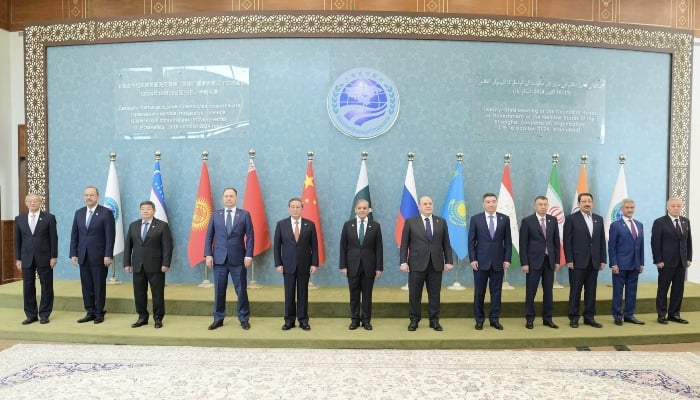What has Pakistan gained after becoming SCO member?
Trade data shows that Pakistan gained considerable benefits from this multilateral platform
October 17, 2024

ISLAMABAD: The Shanghai Cooperation Organisation (SCO) was established on June 15, 2001. It originally emerged from the “Shanghai Five” group, which was formed in 1996.
Pakistan became a full member of the SCO on June 9, 2017, during the SCO Summit in Kazakhstan. The question arises as to what Pakistan has gained so far after becoming an SCO member and what initiatives this forum has taken to ameliorate the lot of people of the member states.
Trade data shows that Pakistan gained considerable benefits from this multilateral platform. Its involvement in the SCO bolstered its regional trade and investment potential, enhanced security cooperation, facilitated access to energy and infrastructure projects, and increased diplomatic influence in Central Asia and beyond.
The SCO also provided Pakistan with opportunities for economic diversification and the ability to play a central role in promoting regional connectivity through initiatives like the China-Pakistan Economic Corridor (CPEC) and broader Silk Road economic corridors.
More importantly, Pakistan’s participation in the SCO enhanced its geopolitical standing by positioning it as a central player in regional cooperation efforts. Being part of the multilateral platform allows Pakistan to play an active role in shaping regional policies and fostering closer ties with Central Asia, China and Russia.
The current SCO moot in Islamabad that ended on Wednesday also provided a positive opportunity for both Pakistan and India to increase interaction, paving the way for normality in their ties as foreign ministers of both nuclear states met during the luncheon and exchanged pleasantries. The Indian foreign minister also held a meeting with Pakistan’s premier.
Pakistan’s trade with SCO member states has grown since it became a member in 2017. China remains the dominant trade partner within the SCO, with the trade volume exceeding $27 billion annually.
Trade with Central Asian countries has also been increasing, with Pakistan aiming to enhance its role as a trade and transit hub between Central Asia and global markets.
The bilateral trade between Pakistan and China has seen substantial growth, particularly through CPEC and as part of broader initiatives under the Belt and Road Initiative (BRI).
According to Pakistan’s Ministry of Commerce, trade between Pakistan and China stood at around $27 billion in 2022. This includes exports from Pakistan to China (e.g., textiles, agricultural products, minerals) and imports from China (e.g., machinery, electronics, chemicals, and industrial goods).
The China-Pakistan Free Trade Agreement (CPFTA), signed under the framework of SCO further facilitated trade by reducing tariffs on goods and increasing bilateral economic activity.
Russia and Pakistan have been building closer economic ties, particularly in energy, defence, and trade. The bilateral trade was approximately $1.5 billion in 2022, with major imports from Russia including oil, gas, and fertilisers, and exports including textiles and agricultural products.
Both countries are keen to expand economic relations, especially in the fields of energy (oil and gas pipelines) and trade infrastructure.
While India is a fellow SCO member, the trade between Pakistan and India is limited due to geopolitical tensions, especially since the cancellation of the most-favoured-nation (MFN) status for Pakistan by India in 2019 and the broader political discord.
Bilateral trade declined significantly in recent years due to the strained political environment. In 2018, trade was valued at about $2 billion, but it dropped to a fraction of that due to the border tensions and suspension of trade in 2019.
Political normalisation could potentially lead to a significant boost in trade, but this remains contingent on broader political developments.
Trade with Central Asian member states Kazakhstan, Kyrgyzstan, Uzbekistan, and Tajikistan, which are also SCO member states, has been gradually increasing as Pakistan looks to expand its trade routes to landlocked Central Asia through its position as a regional transit hub.
Trade with Kazakhstan was around $450 million in 2022.
Key exports from Pakistan include textiles, rice and agricultural products, while imports from Kazakhstan include oil, gas, and minerals. Bilateral trade with Uzbekistan reached approximately $400 million in 2022, with strong potential for growth due to economic reforms and cooperation in agriculture, textiles, and energy sectors.
Trade with Kyrgyzstan and Tajikistan remains relatively small but growing, with exports largely consisting of textiles, agricultural products, and consumer goods, and imports focused on minerals and energy resources.
Central Asia is a priority for Pakistan, and trade is expected to grow as road and rail connectivity improves under initiatives like CPEC and the Tashkent Agreement, which facilitates trade between Central Asia and Pakistan. There have been ongoing discussions about the possibility of establishing a Free Trade Area within the SCO. This would enhance trade among members by reducing tariff barriers and creating a common platform for easier movement of goods, services, and investment.
The SCO has, indeed, taken initiatives to promote trade among its member states using local currencies, aiming to reduce dependence on global currencies like the US dollar and enhance regional economic integration. One of the notable initiatives is establishment of a Local Currency Payment Mechanism (LCPM), which allows the SCO member countries to settle trade transactions in their respective local currencies rather than relying on international currencies like the US dollar or the Euro. This reduces the cost of trade by eliminating currency exchange and transaction fees, and also minimises exposure to fluctuations in the exchange rate of major global currencies.
This initiative helps member states bypass financial sanctions imposed by non-member countries, reduces dependence on Western financial systems, and strengthens regional economic integration. This system is being progressively implemented, and some countries within the SCO have already begun using local currencies for trade. This is particularly significant for countries like China (with its renminbi), Russia (with its ruble), and others like India, Kazakhstan, and Pakistan, which have strong regional economic ties.
Some SCO members have already entered into currency swap agreements, which allow them to trade goods and services directly in their local currencies, rather than using third-party currencies. The SCO members have begun to prioritise bilateral trade agreements that specifically promote the use of local currencies. For example: A significant portion of the bilateral trade between China and Pakistan is already conducted in Chinese yuan (CNY) and Pakistani rupee (PKR). This is part of Pakistan’s broader initiative to reduce dependency on the US dollar.
Trade between China and Kazakhstan is increasingly settled in yuan and tenge (KZT), strengthening the regional economic ties and reducing transaction costs.
China, as the largest economy within the SCO, has been actively promoting its currency, the yuan (renminbi), for regional trade and investments. The People’s Bank of China (PBoC) has signed currency swap agreements with several SCO member countries to encourage the use of yuan in bilateral trade. This has helped foster the use of local currencies and decreased reliance on the US dollar in the region. China has been particularly active in Central Asia, where countries like Kazakhstan, Kyrgyzstan, and Uzbekistan have signed agreements to allow trade settlements in yuan. These agreements enhance economic cooperation and increase financial stability in the region. There has been increasing talk within the SCO to establish a regional payments system that would enable faster and cheaper transactions in local currencies. This system could be seen as a regional counterpart to global payment networks like SWIFT but would operate primarily within the SCO member states.
Disclaimer: The viewpoints expressed in this piece are the writer's own and don't necessarily reflect Geo.tv's editorial policy.
Originally published in The News











